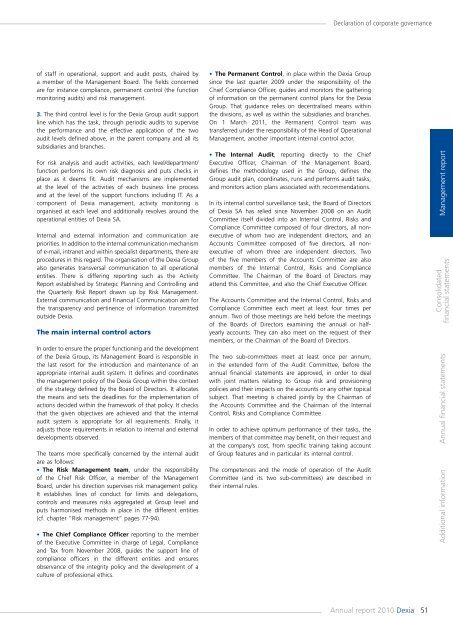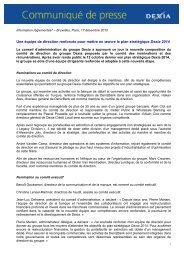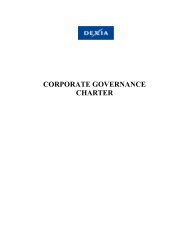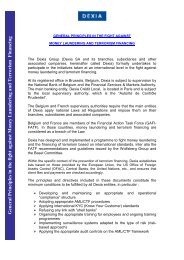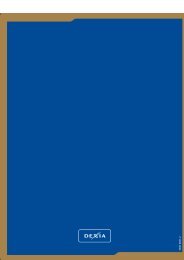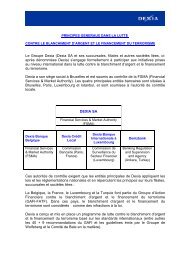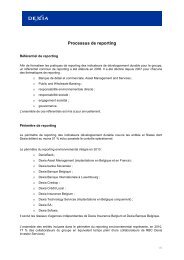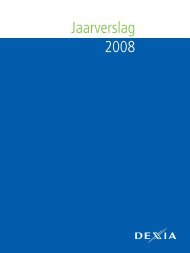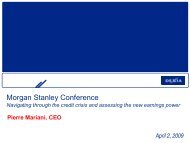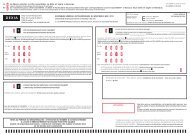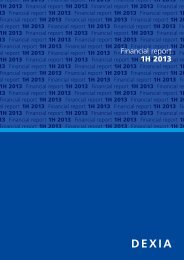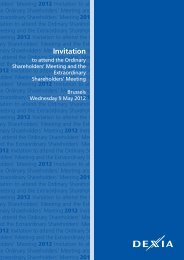Annual report 2010 - Dexia.com
Annual report 2010 - Dexia.com
Annual report 2010 - Dexia.com
- No tags were found...
Create successful ePaper yourself
Turn your PDF publications into a flip-book with our unique Google optimized e-Paper software.
Declaration of corporate governanceof staff in operational, support and audit posts, chaired bya member of the Management Board. The fields concernedare for instance <strong>com</strong>pliance, permanent control (the functionmonitoring audits) and risk management.3. The third control level is for the <strong>Dexia</strong> Group audit supportline which has the task, through periodic audits to supervisethe performance and the effective application of the twoaudit levels defined above, in the parent <strong>com</strong>pany and all itssubsidiaries and branches.For risk analysis and audit activities, each level/department/function performs its own risk diagnosis and puts checks inplace as it deems fit. Audit mechanisms are implementedat the level of the activities of each business line processand at the level of the support functions including IT. As a<strong>com</strong>ponent of <strong>Dexia</strong> management, activity monitoring isorganised at each level and additionally revolves around theoperational entities of <strong>Dexia</strong> SA.Internal and external information and <strong>com</strong>munication arepriorities. In addition to the internal <strong>com</strong>munication mechanismof e-mail, intranet and within specialist departments, there areprocedures in this regard. The organisation of the <strong>Dexia</strong> Groupalso generates transversal <strong>com</strong>munication to all operationalentities. There is differing <strong>report</strong>ing such as the ActivityReport established by Strategic Planning and Controlling andthe Quarterly Risk Report drawn up by Risk Management.External <strong>com</strong>munication and Financial Communication aim forthe transparency and pertinence of information transmittedoutside <strong>Dexia</strong>.The main internal control actorsIn order to ensure the proper functioning and the developmentof the <strong>Dexia</strong> Group, its Management Board is responsible inthe last resort for the introduction and maintenance of anappropriate internal audit system. It defines and coordinatesthe management policy of the <strong>Dexia</strong> Group within the contextof the strategy defined by the Board of Directors. It allocatesthe means and sets the deadlines for the implementation ofactions decided within the framework of that policy. It checksthat the given objectives are achieved and that the internalaudit system is appropriate for all requirements. Finally, itadjusts those requirements in relation to internal and externaldevelopments observed.The teams more specifically concerned by the internal auditare as follows:• The Risk Management team, under the responsibilityof the Chief Risk Officer, a member of the ManagementBoard, under his direction supervises risk management policy.It establishes lines of conduct for limits and delegations,controls and measures risks aggregated at Group level andputs harmonised methods in place in the different entities(cf. chapter “Risk management” pages 77-94).• The Chief Compliance Officer <strong>report</strong>ing to the memberof the Executive Committee in charge of Legal, Complianceand Tax from November 2008, guides the support line of<strong>com</strong>pliance officers in the different entities and ensuresobservance of the integrity policy and the development of aculture of professional ethics.• The Permanent Control, in place within the <strong>Dexia</strong> Groupsince the last quarter 2009 under the responsibility of theChief Compliance Officer, guides and monitors the gatheringof information on the permanent control plans for the <strong>Dexia</strong>Group. That guidance relies on decentralised means withinthe divisions, as well as within the subsidiaries and branches.On 1 March 2011, the Permanent Control team wastransferred under the responsibility of the Head of OperationalManagement, another important internal control actor.• The Internal Audit, <strong>report</strong>ing directly to the ChiefExecutive Officer, Chairman of the Management Board,defines the methodology used in the Group, defines theGroup audit plan, coordinates, runs and performs audit tasks,and monitors action plans associated with re<strong>com</strong>mendations.In its internal control surveillance task, the Board of Directorsof <strong>Dexia</strong> SA has relied since November 2008 on an AuditCommittee itself divided into an Internal Control, Risks andCompliance Committee <strong>com</strong>posed of four directors, all nonexecutiveof whom two are independent directors, and anAccounts Committee <strong>com</strong>posed of five directors, all nonexecutiveof whom three are independent directors. Twoof the five members of the Accounts Committee are alsomembers of the Internal Control, Risks and ComplianceCommittee. The Chairman of the Board of Directors mayattend this Committee, and also the Chief Executive Officer.The Accounts Committee and the Internal Control, Risks andCompliance Committee each meet at least four times perannum. Two of those meetings are held before the meetingsof the Boards of Directors examining the annual or halfyearlyaccounts. They can also meet on the request of theirmembers, or the Chairman of the Board of Directors.The two sub-<strong>com</strong>mittees meet at least once per annum,in the extended form of the Audit Committee, before theannual financial statements are approved, in order to dealwith joint matters relating to Group risk and provisioningpolicies and their impacts on the accounts or any other topicalsubject. That meeting is chaired jointly by the Chairman ofthe Accounts Committee and the Chairman of the InternalControl, Risks and Compliance Committee.In order to achieve optimum performance of their tasks, themembers of that <strong>com</strong>mittee may benefit, on their request andat the <strong>com</strong>pany’s cost, from specific training taking accountof Group features and in particular its internal control.The <strong>com</strong>petences and the mode of operation of the AuditCommittee (and its two sub-<strong>com</strong>mittees) are described intheir internal rules.Management <strong>report</strong>Consolidatedfinancial statementsAdditional information <strong>Annual</strong> financial statements<strong>Annual</strong> <strong>report</strong> <strong>2010</strong> <strong>Dexia</strong>51


